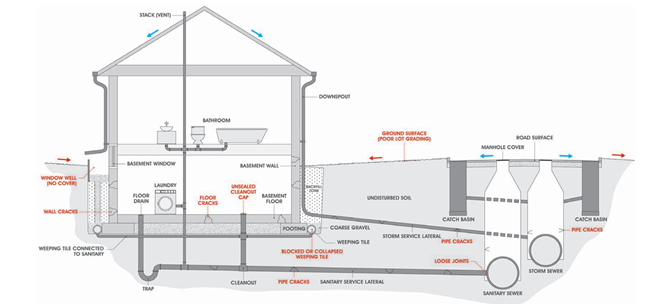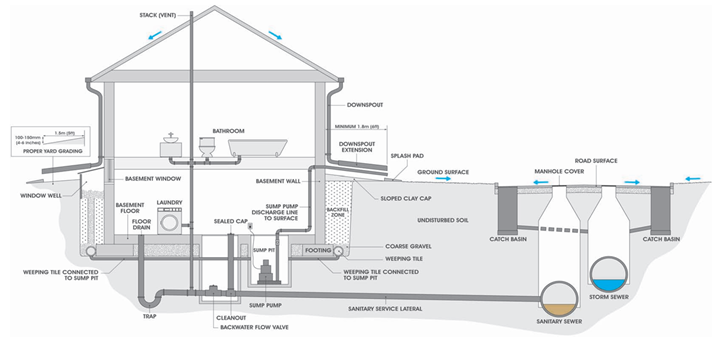Member Knowledge Centre
 member Knowledge centre
member Knowledge centre
The Knowledge Centre provides CHBA members with access to information and resources. It is a growing resource that is currently focused on updating members about national building code information. Please note that this information is a benefit of your membership, and should not be shared beyond your company/organization.
You can browse the items below, filter by category, or enter search terms in the "What are you looking for" box below.
Protecting Homes Against Basement Flooding

Protecting Homes Against Basement Flooding
August 1, 2025
Protecting Basements from Flooding Makes Sense
20% of Canadian homes are at risk of basement flooding due to Canada s changing climate patterns, aging infrastructure, and ongoing urbanization. Flooding has emerged as the costliest natural disaster across Canada, with water-related damages accounting for more than half of losses insured from extreme weather events. The financial burden on homeowners, $43,000 on average, is substantial and includes damage to the structure, lost time at work, but does not include the loss of irreplaceable sentimental belongings. In addition to monetary losses, basement flooding poses significant health risks due to mold growth in damp environments and contributes to long-term stress.
To protect the investment of homeowners, homes can be designed and renovated to withstand increasingly severe weather events. While the National Building Code is expected to include advanced flooding resilience measures by 2030, best-practice builders and renovators can incorporate advanced flood-resilient practices into their projects today to safeguard homes and reduce the financial burden on homeowners. Plus, progressive insurers may offer incentives.
Understanding Points of Failure
It is important to understand what causes these floods from a design and maintenance perspective to minimize damage to millions of homes in Canada. The primary causes of basement flooding include heavy rainfall that overwhelms municipal stormwater systems, sump pump failures, sewer backups, and improper grading around homes that leads to water pooling near foundations. Blocked or disconnected downspouts also contribute significantly to flooding risks. Below is a diagram that outlines the possible points of failure and design issues in a basement foundation that can result in basement flooding.

Figure 2 : Foundation prone to flooding due to points of failure
Points of Failure/bad design | Description |
Unsealed Cracks | The cracks in the foundation wall and basement floor are unsealed. |
Downspouts Issues | Downspouts are connected to the municipal sewer system or are discharging too close to the foundation. |
Improper Yard Grading | The yard is improperly graded and sloped toward the home. |
Weeping Tile Connection | The weeping tiles are connected to the sanitary sewer lateral. |
Weeping Tile Maintenance | The weeping tiles have not been maintained and are damaged. |
Missing Backwater Valve | There is no backwater valve in place. |
Sewer Lateral Issues | The sewer laterals have not been maintained, are cracked, and have loose joints. |
Storm Sewer Lateral Issues | The storm sewer lateral has not been severed and is prone to exfiltration. |
Uncapped Backfill | The backfill area beside the foundation wall is uncapped. |
Unsealed Sewer Cleanout | The sewer cleanout is uncapped and unsealed. |
Missing Window Well Cover | There is no window well cover in place. |
Technical Strategies for Flood Resilience
These challenges highlight the need for builders and renovators to adopt proactive strategies that address these vulnerabilities during construction and renovation. In contrast to the diagram above, below is a diagram depicting good design practices to help minimize the risk of flooding.

Figure 3 : Well-built foundation
Good Design | Description |
Properly Graded Yard | A properly graded yard directs water away from the home. |
Backfill Zone Capped | The backfill zone has been capped with an impermeable soil. |
Downspouts Disconnected | The downspouts have been disconnected from the municipal sewer system. |
Extensions on Downspouts | Extensions on the eavestrough downspouts and sump-pump discharge pipe keep water away from the home. |
Window Well Cover | A cover has been placed on the window well. |
Foundation Cracks Sealed | Cracks in the foundation walls and basement floor have been sealed. |
Weeping Tiles Repaired | Weeping tiles have been repaired and are in good working order. |
Backwater Valve Installed | A mainline, normally open backwater valve has been installed in the sanitary sewer lateral. |
Sump-Pit and Sump-Pump | Weeping tiles are drained into a sump-pit, and water is pumped from the basement to the surface |
Sanitary Sewer Lateral | Cracks and loose joints in the sanitary sewer lateral have been repaired. |
Storm Sewer Lateral Severed | The storm sewer lateral has been severed. |
Marketing Flood-Resilient Homes
Results from a survey conducted by CHBA and the Institute for Catastrophic Loss Reduction (ICLR), show that some home buyers and homeowners are willing to make a one-time investment for their home between $5,000 and $25,000 to add resilience features, including flood protection measures. This presents an opportunity for builders, developers and renovators to incorporate advanced flood protection measures into new and existing homes. These strategies listed above help reduce future repair costs, they can limit warranty claims, and maintain the value of homes as severe climate events increase.
In some cases, resilience measures may maintain insurability or lead to lower insurance premiums, offering current and future homeowners added financial relief. As climate risks become a bigger consideration for home buyers, these features support both individual homeowners and the wider goal of building more resilient communities.
Other Resources
Additional information can be found in this report Under One Umbrella, and in this Home Flood Protection Infographic. More detail is provided in this Handbook for Reducing Basement Flooding, or in the CSA Z800 Guideline on Basement Flood Protection and Risk Reduction.
For more information, contact bilal.el-zaylaa@chba.ca
Additional Info
Download File : Protecting Basements from Flooding.pdf

